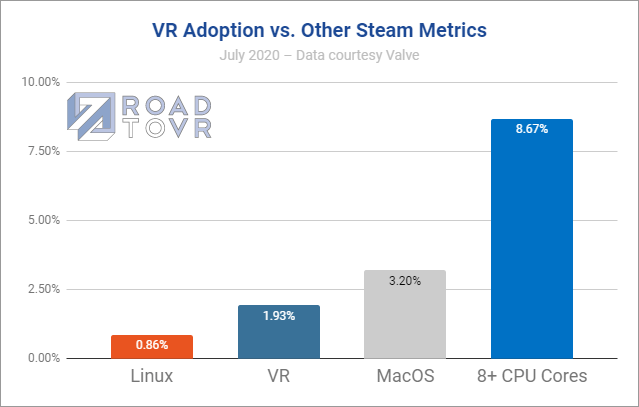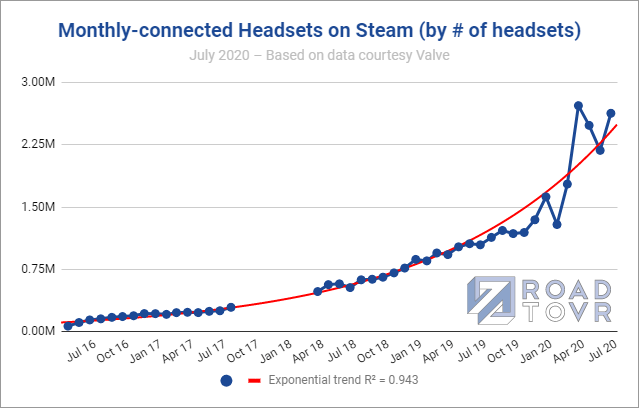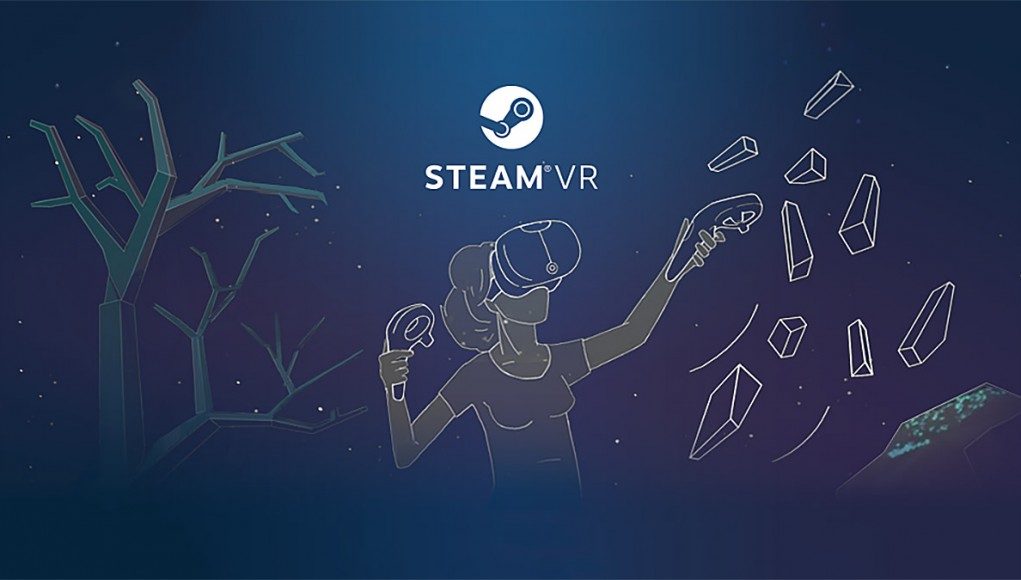Half-Life: Alyx led to a huge leap in VR usage on Steam when it launched back in March. Four months later, there’s nearly as many VR headsets on Steam as there were right after the game’s launch.
Each month Valve collects info from Steam users to determine some baseline statistics about what kind of hardware and software is used by the platform’s population, and to see how things are changing over time, including the use of VR headsets.
While we had expected that Half-Life: Alyx would lead to a surge in VR usage on Steam, we also figured that only a portion of that surge would remain in the long run. Surprisingly, Steam appears to have retained nearly all of the growth in VR usage brought on by Alyx four months after the launch of the game, according to Valve’s monthly Steam Survey.
In fact, if you look purely at the percentage of Steam users with VR headsets, this month’s figure is slightly higher than the peak brought in by Alyx.
Monthly-connected VR Headsets on Steam
The data shared in the survey represents the number of headsets connected to Steam over a given month, so we call the resulting figure ‘monthly-connected headsets’ for clarity; it’s the closest official figure there is to ‘monthly active VR users’ on Steam, with the caveat that it only tells us how many VR headsets were connected not how many were used.
The latest figures for the month of July show that 1.93% of Steam users had a VR headset connected to their PC over the course of the month, which is actually the highest the percentage of VR users on Steam has ever been.
 To put this into perspective, Steam users with connected VR headsets are about twice as common as those using Linux, and a little more than half as common as those using MacOS.
To put this into perspective, Steam users with connected VR headsets are about twice as common as those using Linux, and a little more than half as common as those using MacOS.
 While Valve’s data is a useful way see which headsets are most popular on Steam, the trend of monthly-connected headsets has always been obfuscated because the data is given exclusively as percentages relative to Steam’s population—which itself is an unstated and constantly fluctuating figure.
While Valve’s data is a useful way see which headsets are most popular on Steam, the trend of monthly-connected headsets has always been obfuscated because the data is given exclusively as percentages relative to Steam’s population—which itself is an unstated and constantly fluctuating figure.
To demystify the data Road to VR maintains a model, based on the historical survey data along with official data points directly from Valve and Steam, which aims to correct for Steam’s changing population to estimate the actual count—not the percent—of headsets being used on Steam.
From the model we estimate there was 2.6 million monthly-connected VR headsets on Steam in July. Although the percentage of VR users in July (1.93%) was ever so slightly higher than the April Alyx peak (1.92%), from a raw number standpoint we estimate that April still held the edge with 2.7 million headsets that month. Still, four months later, nearly all of the Alyx spike has remained.
 As we can see on the graph, June seemed to have a sudden drop but recovered quickly. It isn’t clear if this is just a blip in the data or if June really did see around 400,000 fewer headsets than July. Valve did make some tweaks to the Survey (which now breaks down more headsets and VR streaming drivers), though they didn’t specifically say that a dip would be expected.
As we can see on the graph, June seemed to have a sudden drop but recovered quickly. It isn’t clear if this is just a blip in the data or if June really did see around 400,000 fewer headsets than July. Valve did make some tweaks to the Survey (which now breaks down more headsets and VR streaming drivers), though they didn’t specifically say that a dip would be expected.
Share of VR Headsets on Steam
As for the share of individual headsets on Steam, the biggest winner in July was Valve Index (+1.55%) which now represents 14.45% of all headsets on Steam. That’s surprising considering the significant global backorder that the headset has faced during the Coronavirus pandemic. This may be a sign that Index has begun shipping steadily again, but that Valve is still churning through its backlog of orders.
Oculus Quest also had a big month (+1.26%) for an overall 10.13% share of headsets. If it keeps growing at this rate it may well eclipse Valve’s Index.
 On the losing side, first-gen headsets are giving way to newer headsets. The original Rift CV1 (−1.03%) at 13.63% now holds less than Index for the first time. The original Vive (−1.06%) is declining too but still holds an impressive 23.03% of the share of headsets on Steam.
On the losing side, first-gen headsets are giving way to newer headsets. The original Rift CV1 (−1.03%) at 13.63% now holds less than Index for the first time. The original Vive (−1.06%) is declining too but still holds an impressive 23.03% of the share of headsets on Steam.
Windows VR headsets (−0.99%) have continued their steady decline, now at 7.36% from their June 2019 peak of 11.13%. Later this year HP will launch Reverb G2, the first new Windows VR headset, since Samsung’s Odyssey+ in 2018. We’ll be interested to see if the headset alone can breath new life into the bloc.
Looking at the headset vendors overall, the ‘big two’ still hold strong; Oculus headsets (+0.69%) now hold 45.55% and HTC headsets (−0.89%) 28.82% of all headsets on Steam. Valve (+1.55%) is still a somewhat distant third at 14.45%, but closing the gap as HTC’s overall share of headsets continues to decline from its 39.28% share this time last year. Windows VR headsets (−0.99%) are giving way too, now at just 7.36%.
 As ever, it’s worth noting that the Steam Survey only gives us a glimpse of the overall VR market, as it only counts headsets connected to Steam. That means it doesn’t count some portion of Rift & Quest users which may not use Steam at all, nor other major headsets like PlayStation VR on PS4 and Quest standalone.
As ever, it’s worth noting that the Steam Survey only gives us a glimpse of the overall VR market, as it only counts headsets connected to Steam. That means it doesn’t count some portion of Rift & Quest users which may not use Steam at all, nor other major headsets like PlayStation VR on PS4 and Quest standalone.







